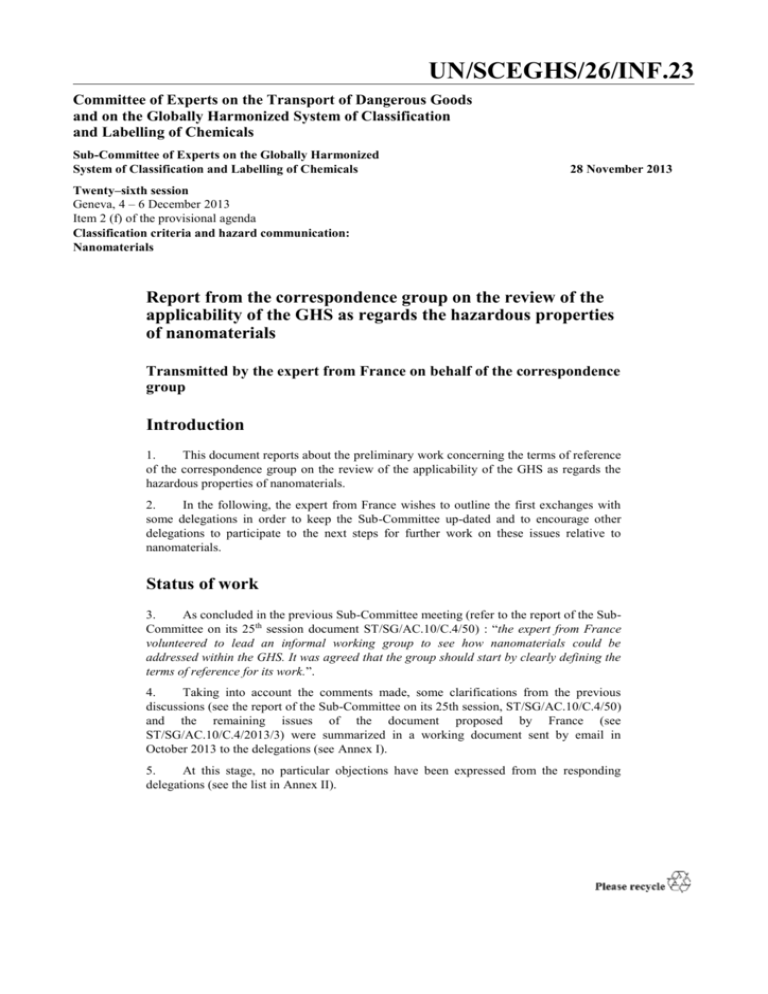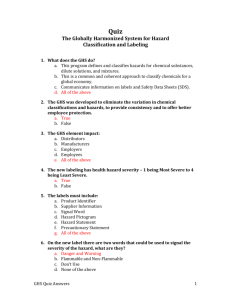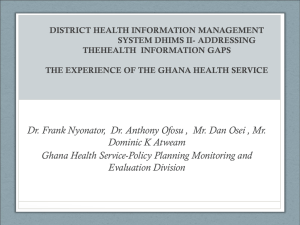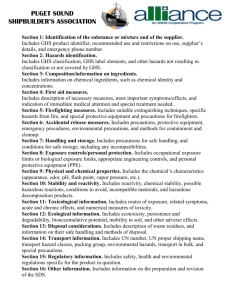UN/SCEGHS/19/INF
advertisement

UN/SCEGHS/26/INF.23 Committee of Experts on the Transport of Dangerous Goods and on the Globally Harmonized System of Classification and Labelling of Chemicals Sub-Committee of Experts on the Globally Harmonized System of Classification and Labelling of Chemicals 28 November 2013 Twenty–sixth session Geneva, 4 – 6 December 2013 Item 2 (f) of the provisional agenda Classification criteria and hazard communication: Nanomaterials Report from the correspondence group on the review of the applicability of the GHS as regards the hazardous properties of nanomaterials Transmitted by the expert from France on behalf of the correspondence group Introduction 1. This document reports about the preliminary work concerning the terms of reference of the correspondence group on the review of the applicability of the GHS as regards the hazardous properties of nanomaterials. 2. In the following, the expert from France wishes to outline the first exchanges with some delegations in order to keep the Sub-Committee up-dated and to encourage other delegations to participate to the next steps for further work on these issues relative to nanomaterials. Status of work 3. As concluded in the previous Sub-Committee meeting (refer to the report of the SubCommittee on its 25th session document ST/SG/AC.10/C.4/50) : “the expert from France volunteered to lead an informal working group to see how nanomaterials could be addressed within the GHS. It was agreed that the group should start by clearly defining the terms of reference for its work.”. 4. Taking into account the comments made, some clarifications from the previous discussions (see the report of the Sub-Committee on its 25th session, ST/SG/AC.10/C.4/50) and the remaining issues of the document proposed by France (see ST/SG/AC.10/C.4/2013/3) were summarized in a working document sent by email in October 2013 to the delegations (see Annex I). 5. At this stage, no particular objections have been expressed from the responding delegations (see the list in Annex II). UN/SCEGHS/26/INF.23 6. But the next discussions shall be focused on (see Annex III for the details): (a) The determination of the tasks of the group in the scope of the GHS (and complementary to those of the other relevant correspondence groups). Each step should be reported back to the Sub-Committee. (b) The characterisation of the technical issues about the classification and labelling criteria for nanomaterials. Those concerning test protocols and methods could be identified, but might not be managed by the group, since such issues are not in the scope of the GHS. And ultimately, (c) To clarify the appropriate information for classification, labelling, and safe use of nanomaterials. Such information might not be limited to supplementary data on physico-chemical properties. Further work 7. As requested by some delegations, a face-to-face meeting may be convened during the December session to continue the discussions on the previous issues explained above and those possibly sent by the delegations after the transmission of this document to the Secretariat. 8. It is assumed that the terms of reference of the correspondence group could be described in a coming formal document for endorsement of the Sub-Committee. In all cases, the group will report about its progress during the next meeting. 9. For the purpose of the review, and based on the terms of reference when approved, it is proposed that during 2014: 2 (a) The group continues the work and presents eventually the reasoning leading to answer if whether and how the GHS criteria can be applied to nanomaterials. (b) The group presents the possible options for further work to amendment the text or clarify the applicability of the GHS and the corresponding technical provisions (classification criteria, SDS, etc.). UN/SCEGHS/26/INF.23 Annex I First working document for comments from the delegations 1. Based on the document proposed by France and the discussions during the last GHS Sub-Committee meeting, the following points shall be noted: (a) The risk management of nanomaterials is a recurring issue at international level (e.g. SAICM) and deserves clarifications in the GHS, in particular the appropriate interpretations to apply the classification criteria. (b) Terms of reference of the informal group shall be established for this purpose and proposed for the endorsement of the GHS sub-committee. (c) It is not necessary to propose a definition of “nanomaterials” in the GHS, since: (i) There are already several internationally recognized definitions which are used not only for classification purpose. (ii) The "nano" nature does not constitute an intrinsic property of danger, but can contribute, case by case, to confer or increase the hazardous properties already defined by the GHS for a dangerous (bulk) substance (eg explosion of nanoparticles). (iii) GHS criteria should cover all chemicals (and all their states) which can be classified as hazardous (d) However, it is necessary to ensure that all relevant intrinsic properties (not only the physico-chemical parameters) are sufficiently specified for the purpose of nanomaterials’ classifications and their communication via the SDS. 2. As a first approach to determine the informal group's terms of reference, it is envisaged: (a) To clarify the relationship of the group with other ones (including those for “explosive dusts” and “contents of the SDS”). (b) To clarify the metrics and methodological problems related to particles. For this aim, the group could prepare a draft mandate for the OECD so that it can specify how to apply the classification criteria (in relation with the corresponding adaptations of the OECD guidelines). (c) To present in fine (in relation with the contributions of the others informal groups) a draft amendment to the text of the GHS to : (i) Identify (additional) specific properties to be considered for purposes of hazard classification and communication through the SDS (ii) Make a clear distinction between the definition of "nanomaterials" (definition outside GHS) and that of "substances classified as dangerous (or maybe with a higher classification than the “bulk” substance) due to their nanometric scale" (should be covered by the GHS). (iii) Clarify and/or revise if necessary the appropriate annexes and provisions in the GHS, on the basis of methodological developments within the OECD. 3 UN/SCEGHS/26/INF.23 Annex II List of the responding delegations Participations Delegations (By status and alphabetic order) Comments from the previous GHS meeting Comments received by email No comments yet, but participation confirmed and contribution envisaged No comments yet, but participation confirmed Governmental Delegations - Member States (Other Bodies) : Australia Canada China Germany Qatar The Netherlands Zambia Governmental Delegations - Member States (Other Bodies) : Belgium Norway Sweden The United Kingdom Non Governmental Organization - NGO Consultative with ECOSOC IPPIC CEFIC Governmental Delegations - Member States (Other Bodies) : Finland Italy The United States of America Intergovernmental Organizations - Intergovernmental Organization : European Union (European Commission) Non Governmental Organization - NGO Consultative with ECOSOC ICCA 5 UN/SCEGHS/26/INF.23 Annex III Resume of the comments received From Australia Comment Australia considers that the same overall approach that is used for chemicals generally can be used to classify nanomaterials and provide hazard information. However, in regard to classification and hazard communication there are some nanomaterial-specific issues. Australia considers that if amendments to cover nanomaterials are necessary then: preferably, general guidance that covers nanomaterial issues should be included in the GHS text guidance, or if that is not feasible guidance specifically on nanomaterials be included. In relation to Annex 1 and the draft terms of reference, we have the following observations: 1. Relationship with other groups We agree it is necessary to clarify the relationship of the group with other ones, including those for “explosive dusts” and “content of the SDS”. 2. Working with the OECD Re: To clarify the metrics and methodological problems related to particles. For this aim, the group could prepare a draft mandate for the OECD so that it can specify how to apply the classification criteria (in relation with the corresponding adaptations of the OECD guidelines). As noted, the OECD has been examining its test guidelines in relation to nanomaterials. We suggest that this point may be amended and the sub-committee requests the OECD to provide specific advice on: How to test nanomaterials for each GHS hazard endpoint – guidelines and amendments needed Australia supports the view as noted that the classification criteria should apply to all chemicals and all their states, including nanomaterials, and thus the issues do not lie in application of the criteria, but in testing against the criteria. 3. Technical issues There are two specific issues we suggest for examination: The classification cut-offs for mixtures. Are they appropriate given that in general, nanoparticles have higher toxicity than larger size particles of the same chemistry? The extent to which read across and other approaches can be used to inform classification, to minimise the need for testing 4. Re: Amendments to text of GHS Re: Make a clear distinction between the definition of "nanomaterials" (definition outside GHS) and that of "substances classified as dangerous (or maybe with a higher classification than the “bulk” substance) due to their nanometric scale" (should be covered by the GHS). We do not think this is necessary as the definition of nanomaterial (e.g. the ISO definition) and whether a substance is dangerous are quite different matters. Belgium [What do you mean] when you say that “it is necessary to ensure that all relevant intrinsinc properties (not only the physic-chemical parameters) are sufficiently specified for the purpose of nanomaterials’ classifications ant their communication via the SDS” ? 7 UN/SCEGHS/26/INF.23 From Norway Comment “It is not necessary to propose a new definition of “nanomaterials” in the GHS[…]” To move this sentence in a new 3rd bullet point in paragraph 1 : “The "nano" nature does not constitute an intrinsic property of danger, but can contribute, case by case, to confer or increase the hazardous properties already defined by the GHS for a dangerous (bulk) substance (eg explosion of nanoparticles).” “However, it is necessary to ensure that all intrinsic properties that are relevant for health and environment assessment (not only the physico-chemical parameters) are sufficiently specified for the purpose of nanomaterials’ classifications and their communication via the SDS. • In lieu of a new definition of nanomaterials in the GHS, reference could be given to one of the internationally recognized definitions when a material is claimed to be in the nanoform.” “Make a clear distinction […] of substances classified as dangerous (or maybe with a higher than or altered classification compared to the the “bulk” substance […]” Attached comment : Nanomaterials may have different properties, not necessarily just be more dangerous. “Clarify and/or revise if necessary the appropriate annexes and provisions in the GHS for environment and health, on the basis of methodological developments within the OECD.” Sweden “It is not necessary to propose a definition of “nanomaterials” in the GHS ” Attached comment : A definition for the purpose of the GHS is desirable to avoid regional differences and legal ambiguity. However, it is envisaged that to get all GHS countries to agree would be a major task. An alternative approach would be to let different regions use their own definitions although this would probably create confusion, economical hinders and loss of public trust. “Although the "nano” nature form of a chemical does not constitute an intrinsic hazardous property of danger per se, but it can nevertheless contribute, case by case, to confer or increase modify the hazardous properties already defined by the GHS for a chemical dangerous (bulk) substance (eg explosion of nanoparticles.” Attached comment : if specific labelling of the chemical in the nano form is required in the future, you have to know what is and what is not a nano form. “GHS criteria should cover all [hazardous] chemicals (and all their states) […]“ Attached comment : Nanomaterials are specific forms (size, shape, crystalline structure, surface properties). of a chemical substance. The hazard classification should cover all forms or physical states in which the substance is manufactured, placed on the market and reasonably be expected to be used. “Make a clear distinction between the definition of "nanomaterials" (definition outside GHS) and that of "substances classified as dangerous (or maybe with a higher classification than the “bulk” substance) due to their nanometric scale" (should be covered by the GHS).” Attached comment : This sentence is unclear 8 UN/SCEGHS/26/INF.23 From UK Comment Our initial thoughts are that there is a need to clarify the purpose and tasks of the Group at the outset, and to check that these keep within the terms of the GHS. One thought concerns the various references to metrics, methodology, methodological developments within OECD, etc. These look like references to test methods. Although there are issues about test methods for nanomaterials, our understanding is that the GHS is intended to be 'test method neutral' and so we wonder if these aspects should be included. We agree that the GHS should not seek to introduce its own definition of nanomaterials, as international (and EU) definitions are already available. As a starting point our perspective would be that nano is one of many possible physical forms of a chemical and that the GHS criteria for hazard classification and labelling should span all forms, distinguishing only as and when necessary. Our initial view is that the terms of reference should reflect a 'one step at a time' approach with a report back to the UNSCEGHS at the end of the each step. For us step 1 might have terms of reference along the following lines: To establish whether there is a need to amend the GHS to make clear that nano forms of a chemical are within scope of the GHS To review the classification and labelling criteria in the GHS to establish whether they are appropriate for nano- as well as bulk-forms of a chemical To review the content of safety data sheets set out in the GHS in terms of their applicability to nano-forms of a chemical To report back to the sub-committee on the outcomes of 1) to 3) and to propose as appropriate further work We agree that it is important to clarify the relationship of the new group with existing ones, including those on content of Section 9 of safety data sheets and explosive dusts. Ideally the relationship would be established at step zero, i.e. before the new group starts its work. The implication would be that the relationships are set out in the Inf paper and agreed by the Subcommittee at the same time as the terms of reference. 9 UN/SCEGHS/26/INF.23 From CEFIC Comment “The "nano" nature […] can contribute, case by case, to confer or increase modify the hazardous properties already defined by the GHS for a dangerous (bulk) substance[…]” Attached comment : Nanomaterials can be more or less hazardous than the bulk or other forms. “However, it is necessary to ensure that all relevant intrinsic properties (not only the physicochemical parameters) are sufficiently specified for the purpose of nanomaterials’ classifications, if applicable, and their communication via the SDS.” Attached comment : This is valid for any substance. “To clarify the metrics and methodological problems related to particles.” Attached comment : Isn’t this more an issue for compliance with a definition, e.g. at EU level? “If considered appropriate, to present in fine (in relation with the contributions of the others informal groups) a draft amendment to the text of the GHS to : o Identify potential (additional) specific properties to be considered for purposes of hazard classification and communication through the SDS o Make a clear distinction between the definition of "nanomaterials" (definition outside GHS) and that of "substances classified as dangerous (or maybe with a higher classification than the “bulk” substance) due to their nanometric scale" (should be covered by the GHS) o Clarify and/or revise if necessary the appropriate annexes and provisions in the GHS, on the basis of methodological developments within the OECD for nanomaterials.” Attached comments : 1st bullet point : We believe the current system is adequate to cover hazards of nanomaterial as well as for any other chemical. Some of the tests used may not be appropriate for nanomaterials (e.g. Ames test), but other relevant tests are available for the considered endpoints. OECD recommendations should be referred to. 2nd bullet point (deleted) : As size does not trigger toxicity, this should not be in. IPPIC IPPIC agrees with this statement [“The "nano" nature does not constitute an intrinsic property of danger, but can contribute, case by case, to confer or increase the hazardous properties already defined by the GHS for a dangerous (bulk) substance (eg explosion of nanoparticles).”], however we do not believe it constitutes a valid reason not to propose a definition of ‘nanomaterial’ in GHS. Therefore we suggest moving the text [in a new 3rd bullet point in paragraph 1]. ___________________________ 10





